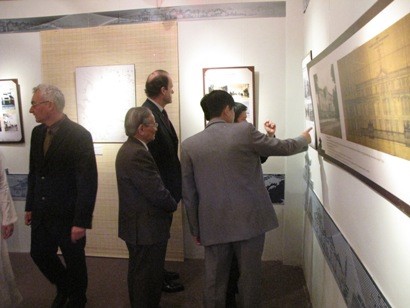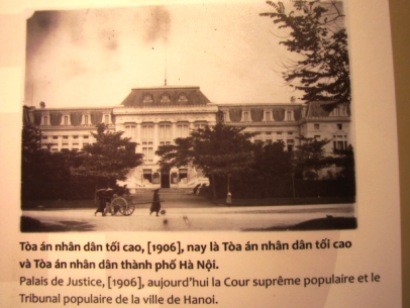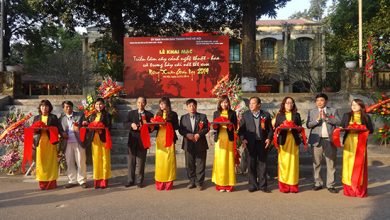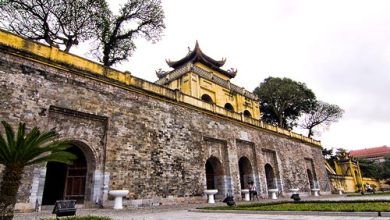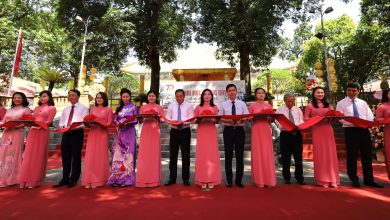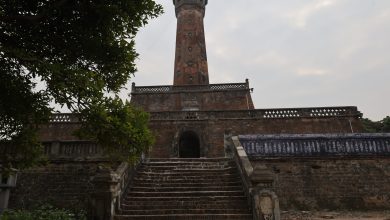Exhibition on Hanoi betwe Tran Temple recognized as special national relic
The decision made by the Prime Minister to recognize Tran Temple and Pho Minh Pagoda as special national relics is the deserving acknowledgement of the work filled with the values demonstrated by the typical characteristics of Tran dynasty – one of the most prosperous dynasty in the feudal history of Vietnam.
Above is addressed by the Deputy Prime Minister Nguyen Thien Nhan at the ceremony held in Nam Dinh to hand over the Certificate of special national relics to Tran temple and Pho Minh pagoda in the evening 5th of October 2012.
Deputy Prime Minister Nguyen Thien Nhan handed over to Nam Dinh Authorities the Certificate of special national relics
Emphasizing on value of this cluster of typical works, the Deputy Prime Minister said that among hundreds of Tran dynasty relics maintained by Nam Dinh province, Tran temple and Pho Minh pagoda are the invaluable property not only to Nam Dinh but nationwide also.
For the great values of Tran temple and Pho Minh pagoda continue to be further promoted, the Deputy Prime Minister asked the local government and people to urgently and seriously implement the master plan for preservation, refurbishment and promotion of the cultural-historical values of Tran temple and Pho Minh pagoda, which have been approved by the Prime Minister.
It is in need to continue study, overall summarization on the special historical, architectural, cultural values of Tran temple, Pho Minh pagoda in particular and Tran dynasty in general, from which lessons will be learned for the building and protection of our motherland today.
Nam Dinh should also make plan for popularizing the historical vestige, architecture of Tran temple, Pho Minh pagoda and Thien Truong palace, simultaneously, managing and bringing this relic site into full play, turning it into a true historical, architectural museum, a solemn place for worshiping, attracting the spiritual sentiment of the people from every corner of the country.
Especially, the Deputy Prime Minister asked Nam Dinh authorities to well organize annual festivals in Tran temple as a folk festival for people; restore healthy cultural activities, religious beliefs, meeting the development requirements and tendency of the society, arousing the pride, gratefulness to the preceding generations; ensuring safety for the people.
The Chairman of Nam Dinh People’s Committee Nguyen Van Tuan confirmed that Nam Dinh’s Party Committee, government and people will continue preserve and promote Tran dynasty’s tradition and spirit, educate Nam Dinh’s young people to have good sense of making contributions to the country development in general and Nam Dinh in particular.
The ceremony took place in the atmosphere of days “Father’s death anniversary in August” (20/8 lunar calendar – death anniversary of Great Lord Tran Quoc Tuan), the last event of the festival celebrating 750 years of Thien Truong- Nam Dinh.
Thang Long – Ha Noi Heritage Conservation Center
en 1873 and 1945
Welcoming the year 2012, in the afternoon on 17/1, at the Thang Long Imperial Citadel, exhibition “Some typical images on Hanoi between 1873 and 1945” was open.
At the exhibition, Mr. Jean Francois Girault- French Ambassador to Vietnam, Mr. Franz Jessen- EU Ambassador to Vietnam, Prof. Phan Huy Le and many historical researchers were present.
The exhibition was organized by the Centre for the Preservation of Thang Long- Hanoi Cultural Heritage in combination with École Française d’Extrême – Orient in order to serve domestic and foreign visitors in Tet holiday.
With more than 80 posters, documents, drawings of architectural works, Hanoi map and living style of new burghers, the exhibition brought the viewers general view on the change of Hanoi from the Oriental urban to Occidental modern urban between 1873 to 1945.
According to Prof. Phan Huy Le, Head of the Vietnam Association of Historical Science, those are original documents which are valuable to those who love Hanoi.
Maps and precious pictures which have been collected for a long time without being known in such period have reflected clearly changes of Hanoi urban with architecture, administrative border, economy, culture and society during more than a half of century.
During such significant change, many architectural vestiges have no longer been existed because of urbanization. However, in addition to ancient Oriental architecture, Occidental architectural works in Hanoi have still remained their value such as Hanoi Opera House, the municipal administration building of Hanoi in 1897 which is Hanoi City People’s Committee now, Long Bien Bridge…


